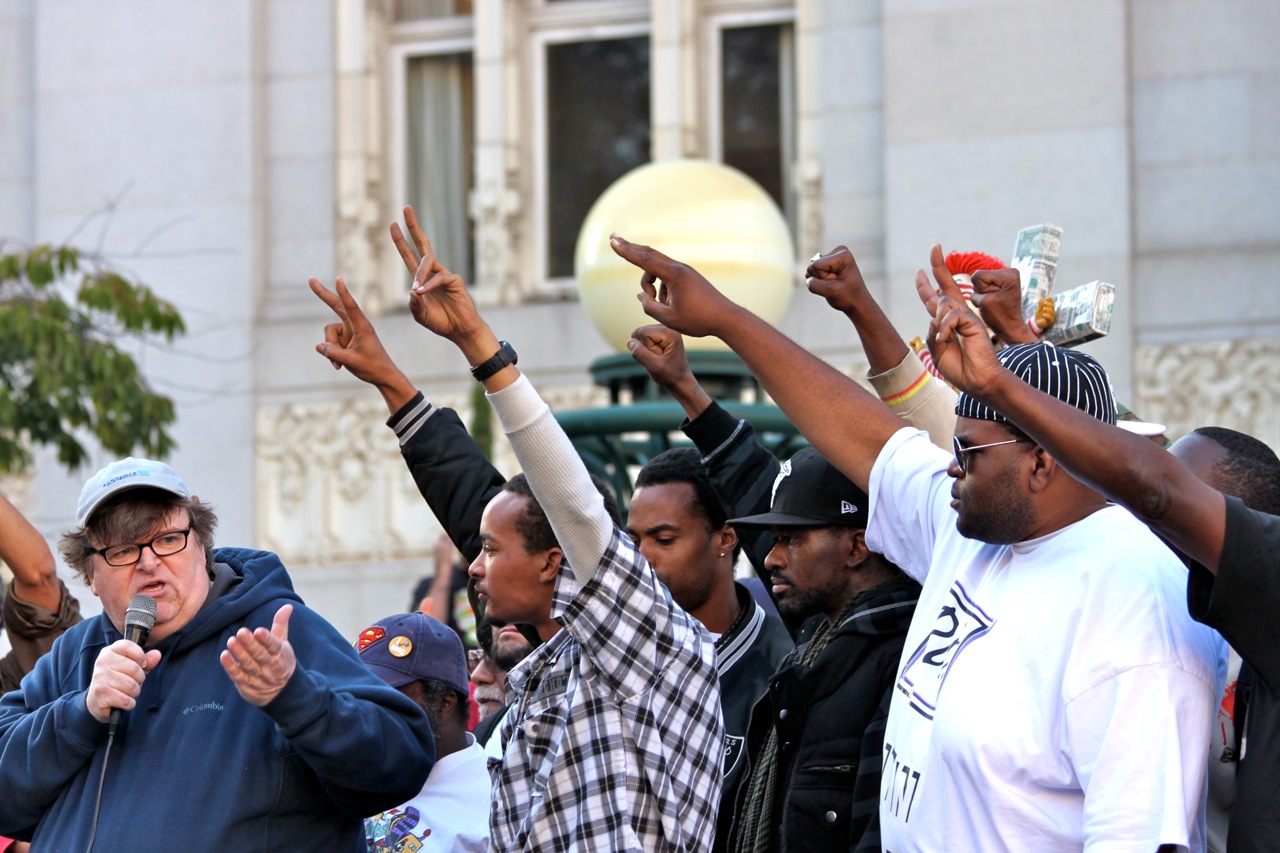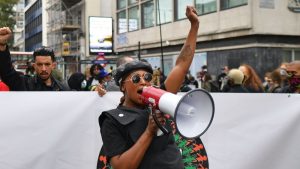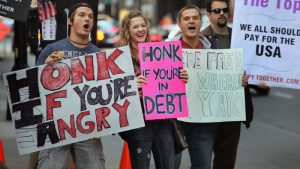
Posted on 30 January 2012 by Cami Graves
FUCK THE POLICE
OPD’s unwarranted reaction to #J28
The streets of Oakland became a war zone Saturday as, once again, the police showed excessive force in their response to Occupy Oakland demonstrations. Over 400 protesters were arrested, and many more, including the elderly, children, and some unwitting passersby, were teargassed and injured during the course of the first day of Occupy Oakland’s Move-In Weekend and Rise Up Festival.
The day began with a march from Oscar Grant Plaza to the location chosen to become Occupy Oakland’s new community center and home, the Kaiser Convention Center, a 215,000 square foot multifunction building that has been empty for nearly six years. The Kaiser Convention Center is publicly-owned, meaning that it should not be unreasonable for its use to be determined by members of the public. Occupy Oakland intended to repurpose the abandoned building for the good of the local community, serving as a place for general assemblies, housing, offices, events, meetings, classes, workshops, and the like.
Things did not go as planned as the police surrounded the building, preventing protesters from coming near. As the march continued, police began using teargas to make the crowd disperse, rushing into the crowd with batons and making numerous arrests. This was only the first in a series of conflicts that lasted until midnight.
Click here for a more detailed account of the day, during which the police repeatedly violated the very laws they are supposed to uphold.
What we learned from the events of Saturday is more of what we already knew–that the resources and institutions that are meant to work for the people are truly inaccessible, even becoming entities to be used against the people. A supposedly publicly-owned space can really be shut down indefinitely and made unavailable to the public pending a 1% government’s unfulfilled desire to sell it to a private interest during a brief real estate boom six years ago. The mayor and city council of the city of Oakland can really lie, cheat, and steal from us without accountability, and even give orders to brutalize us. And the police are not hired to protect and serve the citizenry but to distract us, beat us, and stifle our discontent.
Following this, somehow yet again, unprecedented show of force by the Oakland Police Department, Occupy locations across the country organized events and marches to stand in solidarity, showing that with every show of force, Occupy will only become stronger–because with every show of force, the authorities only expose themselves further. They, like the emperor who has no clothes, are bent on keeping power and exerting control by squashing the truth.
The weekend’s events came on the heels of another action and hotbed topic, the weekly Anti-Repression/ Fuck the Police March organized by the Occupy Oakland Tactical Action Committee. Some don’t agree with the ideology, others don’t agree with the semantics, and yet others don’t agree with some of the strategies advocated by marchers. Let’s take a look at the larger issues.
The Tactical Action Committee has made it clear that the Anti-Repression/ Fuck the Police march is a direct response to OPD abuses of Occupy Oakland–continued harassment, snatch-and-grabs, and use of excessive force, to name a few–but the Oakland Police Department has a long history of misconduct, not to mention that it is not exempt from the many ethical problems haunting the practice of American law enforcement nationwide.
Read the city’s latest press release regarding Saturday’s turmoil.
Mayor Quan and OPD’s response to the past weekend’s events should be an eye-opener for those who don’t understand what the phrase “FUCK THE POLICE” really means in the city of Oakland. It is not a trendy slogan thrown around for shock-value. It indicates a much deeper problem, one that is endemic to Oakland and has its roots at the core of American authoritarianism and exceptionalism.
Consider the Oakland Police Department’s numerous violations against the people of Oakland, spanning back long before Occupy Oakland ever pitched a tent in Oscar Grant Plaza. These violations are what caused OPD to come under scrutiny by the Department of Justice–who have placed constant watchdog Robert Warshaw as overseer of every decision made by the department–and what now potentially put OPD only weeks away from a federal receivership: a complete takeover by the federal government, which will just be a more thorough way to weed out loose cannons and cover up police gaffes.
The long, dark history of a troubled police department
Back in 2000, rookie Oakland police officer Keith Batt caused a stir when he blew the whistle on three of his fellow officers, Jude Siapno, Matthew Hornung, Francisco “Frank” Vazquez, and Clarence “Chuck” Mabanag, under whom Batt was training. Batt accused the four, who were later given the infamous name the Oakland “Riders,” of kidnapping, making false arrests, beating arrestees, falsifying police reports, and forcing Batt to help them cover up their crimes.
At the time, the Riders were the most popular and respected officers on the force, believed to have made a substantial number of drug busts. The reality is that their success was the result of a lot of violence, corruption, and conspiracy.
Three of the officers were charged with multiple felonies. Besides Batt, eight witnesses, all African American men who had been arrested by the four, testified against the Riders. They all claimed to have been beaten and some to having drugs planted on them during their arrests. During the trial, Batt corroborated their stories, describing how one man was pepper-sprayed and beaten before being driven under an overpass, pulled out of the cop cruiser, and beaten further by two of the officers. Batt also described how another man, who had called the cops for assistance, ended up being choked by one of the officers. Finally, Batt described how he was pressured to lie about everything.
Somehow, a (suburban, mostly white with no blacks) jury failed to convict the officers, who maintained their innocence throughout. Were they innocent? Considering the volume of witnesses, one a fellow cop, willing to testify, the ensuing federal investigation of the entire department, and the flight of the “ringleader” of the group, Vazquez, out of the country when the allegations were first made (he is still a fugitive): you tell us.
In the end, all four of the Riders walked free, and two of them asked for their jobs back.
One of the cases made by the defense was that Keith Batt was a “naive rookie with little understanding of the ways of an urban police department fighting a deadly drug war.” In the words of one of the Rider’s defense attorney, Michael Rains, “You don’t send choirboys out to West Oakland to get rid of drug dealers.” No, of course not. You send thugs.
Envision what it would be like if police like Keith Batt refused to play malicious games with peoples’ lives and came forward to report their corrupt peers. What would we find?
Unfortunately, stories of police misconduct and brutality–especially in the troubled communities of Oakland–often receive little to no attention. Or, somehow, we forget them. Numbers of how many of the innocent have been killed by Oakland police may be impossible to know, let alone true numbers of those beaten and unlawfully arrested. This doesn’t mean those stories don’t exist.
But even when we know these stories, how often are complaints sustained, charges filed, and violators indicted and convicted?
With the federal government’s ongoing investigations of OPD, it’s probably safe to assume that Internal Affairs cannot be trusted. We might also want to keep in mind that the 2009 head of OPD Internal Affairs, Capt. Edward I. Poulson, became subject to an FBI probe after information resurfaced that he had badly beaten a man, Jerry Amaro, nine years before. The injuries sustained by Amaro were enough to cause his death a month later. Not only did Poulson lie about the incident, but he ordered his subordinates to lie. When his subterfuge was discovered by Internal Affairs at the time, he was suspended for two months. We might not want to know what OPD Internal Affairs is up to in 2012.
That leaves us with the Oakland Citizens’ Police Review Board. Sadly, the CPRB’s reports don’t provide enough insight into the truth of Oakland police behavior except that most complaints filed with the board against the police come from African American and Hispanic men and most often include excessive use of force and unlawful arrest. (It’s important to note that the CPRB doesn’t have the staff or the resources to properly address Oakland police department problems.) Their recommendations for how to deal with police behavior have obviously gone unheeded, while the Oakland Police Department continues to rampage. We do know a few more stories of OPD’s crimes:
In a high-profile 2007 incident, Oakland Post editor-in-chief Chauncey Bailey was assassinated in downtown Oakland by an employee of Your Black Muslim Bakery, which was operated at the time by Yusuf Bey IV. Bey’s father was at the center of a small Muslim black empowerment movement, as well as a ring of crime. The older Bey rubbed shoulders with local politicians, and his bakery was so popular that a power struggle for its control ensued upon his death. Chauncey Bailey’s attempts to uncover that struggle led to his assassination, which the younger Bey had ordered, and for which he was convicted in 2011.
Following Bailey’s death, allegations arose that homicide detective Sgt. Derwin Longmire, who was close friends with Bey, had mishandled the investigation and had either attempted to or made an agreement to protect Bey. Longmire allowed Bey and Bailey’s murderer, Devaughdre Broussard, to speak together alone and unrecorded, as well as failed to note GPS tracking and phone logs as evidence. Despite his clear conflict of interest and confusing handling of the case, Longmire is still with the Oakland Police Department, possibly because firing him would mean bringing attention to some mistakes of their own.
In another incident in 2007, the city of Oakland was forced to pay $6 million in damages to Torry Smith after a jury found two police guilty of planting a rifle in Smith’s back yard and then arresting him for having it. The city later complained as though Oakland officers were incapable of such a plot, with the defense’s attorney saying, “To reach this decision, the jury had to believe that two highly respected officers, in uniform, in a community where they are well known, in broad daylight, carried a 2 1/2-foot assault rifle from their car and planted it in the backyard of a man they had never even heard of before that day.” Coincidentally, the prosecuting attorney had also represented some of the plaintiffs in a civil suit against the Riders a few years before, which the city settled by awarding the plaintiffs $10.5 million.
A comprehensive and perceptive report by Ali Winston for Colorlines.com details the 2003 “Copley ruling,” a decision made by the California Supreme Court that limited public access to police records and had a profound impact on police transparency. Winston’s report includes discussion of the ruling’s impact on Oakland specifically. He talks especially about the recklessness and misconduct of one notorious officer, Sgt. Patrick Gonzales, whose actions may have caused the deaths of two of his fellow officers in a March 2009 raid, as well as some disturbing statistics on trigger-happy Oakland cops.
Gonzales, who Winston alleges is one of sixteen officers responsible for the 85 police shootings that occurred in Oakland between 2000 and 2010, is behind a multitude of violations. These include not only the raid in 2009, which left Lovelle Mixom and a total of four officers dead, but also the fatal 2002 shooting of Joshua Russell, the 2006 shooting of Amir Rollins that left Rollins a quadriplegic (Rollins says he had already put down his weapon when Gonzales shot him), and the fatal 2007 shooting of Gary King, Jr., an innocent man who was running away from Gonzales after being arbitrarily stopped and assaulted by him, calling for help.
In a little over the past year alone, at least four instances of OPD slayings of innocent people have made a small dent in the press:
In November 2010, police shot and killed Derrick Jones, who was unarmed, as many as eight times. Jones had been in earlier altercations with his girlfriend, but a friend said he didn’t call the cops because he “was afraid something like this would happen.”
In January 2011, Matthew Cicelski, a Gulf War veteran suffering from PTSD and a more recent head injury, was gunned down by police in front of his ex-girlfriend’s home for carrying a toy gun around his neighborhood. The police had been informed that Cicelski needed mental health assistance, that the gun was not real, and that they should not shoot.
Also in January 2011, the Oakland School Police Department, who are close partners with the Oakland Police Department, shot and killed 20-year-old Raheim Brown. Their reason for pulling the trigger was that he was holding a screwdriver and, according to them, trying to stab a cop. Brown was shot five times, twice in the head.
In September 2011, witnesses, one an eleven-year-old boy, reported that cops fatally shot a suspect four times in the back after he had raised his hands in surrender. This story received little to no follow-up.
So remind us again whom the perpetrators are in Oakland…
To be sure, these are only a small portion of OPD’s crimes and are probably nothing compared to what we might discover were we to explore every police department in America. Yet Mayor Jean Quan continues to use this disgraced police department against Occupy Oakland, a police department that needs to be babysat and is under investigation for murder, abuse, conspiracy, and fraud.
Just last Wednesday, Judge Thelton Henderson warned Quan that after ten years of waiting for OPD to shape up, he was appalled by the city’s failure to comply with orders for long-expected reform. This warning came in the wake of overseer Warshaw’s criticism of the city’s handling of Occupy protests.
But Quan claims that Occupy Oakland are the ones antagonizing the city. We are costing the city millions (how many millions has Oakland paid to the victims of its police force, again? How many millions more would it have to pay if we only knew everything they’ve done?). We are diverting important attention away from the neighborhoods who need it, as though Occupy Oakland has really disrupted OPD’s long history of defending and guarding the innocent of this city.
Actually, it seems more like Quan is more concerned with strangling protest than she is with policing, or, heaven forbid, providing effective services and aid, to the parts of Oakland that have already been long neglected.
How OPD is treating protesters is shameful, but in light of how we’ve seen them operate and continually get away with it, we should realize that we can hardly fathom the frightful grip OPD has on the Oakland residents it most often targets.
While we can see that the police force’s behavior toward Occupy Oakland is certainly not the first or most brutal of its many offenses, it is an extension of every other offense: of the failure to protect and serve those in society who are most in need of protection and service; of the commitment to perpetuate a bigoted and marginalizing status quo by suppressing only certain members of society while others are allowed to get away with psychological and economic crimes against the entire population; and, perhaps most of all, of the astonishing refusal to take responsibility for the terrifying trail of death and destruction it has left in its wake.
Quan also wants the public to believe that Occupy Oakland is made up of outsiders, and there are few Oakland natives and people of color in the movement. This is definitively not true, and many of our most impassioned members, those organizing marches and occupations, are native Oaklanders who know all about the Oakland police’s tactics. Occupy Oakland says “FUCK THE POLICE” because OPD has for too long been allowed to brutalize Oakland’s communities, and now they are being used to stamp out our right to protest against the complex systems that allow, even encourage, that brutalization.
If you are out there and you think OPD is looking out for the people, protecting Oakland from us oppressive, complaining Occupiers, you are dead wrong. You are dead, dead wrong. If you think the city’s handling of Occupy Oakland by using this murderous police force means that the city is doing its best for Oakland, you are dead wrong. In fact, if you think that any militaristic force within or outside of the United States is here to look after you, the ordinary citizen: think of Oakland. OPD’s inevitable movement toward receivership is just one instance in which the police’s reign of terror against citizens has been–at least partially–exposed. But this isn’t enough.
Imagine what else your government is hiding from you and trying to make you forget while they pretend to be working for you. We have yet to make people really see the crooked intentions of those who order the police around and cover for them. Remember that if you, the ordinary citizen, don’t police the police, you have no reason to hope that your government will.








